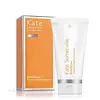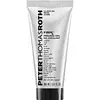What's inside
What's inside
 Key Ingredients
Key Ingredients

 Benefits
Benefits

 Concerns
Concerns

 Ingredients Side-by-side
Ingredients Side-by-side

Water
Skin ConditioningLactic Acid
BufferingSilica
AbrasiveGlycine Soja Oil
EmollientPectin
Emulsion StabilisingCetearyl Alcohol
EmollientCarica Papaya Fruit
Skin ConditioningCeteareth-20
CleansingCetyl Alcohol
EmollientPhenoxyethanol
PreservativeDehydroxanthan Gum
Emulsion StabilisingGlyceryl Stearate
EmollientPEG-100 Stearate
Salicylic Acid
MaskingLactobacillus/Pumpkin Ferment Extract
Skin ConditioningAlcohol Denat.
AntimicrobialSorbic Acid
PreservativeCinnamal
PerfumingMel
EmollientCitrus Aurantium Bergamia Fruit Oil
MaskingEugenol
PerfumingPotassium Sorbate
PreservativeLimonene
PerfumingLinalool
PerfumingLavandula Angustifolia Oil
MaskingBeta-Carotene
Skin ConditioningAloe Barbadensis Leaf Juice Powder
Skin ConditioningBromelain
Skin ConditioningPapain
Skin ConditioningRetinyl Palmitate
Skin ConditioningTocopheryl Acetate
AntioxidantCinnamomum Cassia Leaf Oil
MaskingAcetic Acid
BufferingPogostemon Cablin Leaf Oil
MaskingPelargonium Graveolens Flower Oil
MaskingAniba Rosaeodora Wood Extract
MaskingCitrus Aurantium Dulcis Peel Oil
MaskingCI 75810
Cosmetic ColorantWater, Lactic Acid, Silica, Glycine Soja Oil, Pectin, Cetearyl Alcohol, Carica Papaya Fruit, Ceteareth-20, Cetyl Alcohol, Phenoxyethanol, Dehydroxanthan Gum, Glyceryl Stearate, PEG-100 Stearate, Salicylic Acid, Lactobacillus/Pumpkin Ferment Extract, Alcohol Denat., Sorbic Acid, Cinnamal, Mel, Citrus Aurantium Bergamia Fruit Oil, Eugenol, Potassium Sorbate, Limonene, Linalool, Lavandula Angustifolia Oil, Beta-Carotene, Aloe Barbadensis Leaf Juice Powder, Bromelain, Papain, Retinyl Palmitate, Tocopheryl Acetate, Cinnamomum Cassia Leaf Oil, Acetic Acid, Pogostemon Cablin Leaf Oil, Pelargonium Graveolens Flower Oil, Aniba Rosaeodora Wood Extract, Citrus Aurantium Dulcis Peel Oil, CI 75810
Water
Skin ConditioningPEG-32
HumectantCellulose
AbsorbentButylene Glycol
HumectantCitrus Aurantium Bergamia Fruit Water
Skin ConditioningSorbitol
HumectantR-Bacillus Licheniformis Keratinase
Skin ConditioningAnanas Sativus Fruit Extract
Skin ConditioningLactobacillus/Punica Granatum Fruit Ferment Extract
Skin ConditioningLeuconostoc/Radish Root Ferment Filtrate
AntimicrobialSodium Hyaluronate
HumectantGlycerin
HumectantSodium Hydroxide
BufferingCitric Acid
BufferingTetrasodium EDTA
Algin
MaskingCarbomer
Emulsion StabilisingTromethamine
BufferingIsopropyl Myristate
EmollientSodium Chloride
MaskingCalcium Chloride
AstringentPotassium Sorbate
PreservativeSodium Benzoate
MaskingMica
Cosmetic ColorantPhenoxyethanol
PreservativeWater, PEG-32, Cellulose, Butylene Glycol, Citrus Aurantium Bergamia Fruit Water, Sorbitol, R-Bacillus Licheniformis Keratinase, Ananas Sativus Fruit Extract, Lactobacillus/Punica Granatum Fruit Ferment Extract, Leuconostoc/Radish Root Ferment Filtrate, Sodium Hyaluronate, Glycerin, Sodium Hydroxide, Citric Acid, Tetrasodium EDTA, Algin, Carbomer, Tromethamine, Isopropyl Myristate, Sodium Chloride, Calcium Chloride, Potassium Sorbate, Sodium Benzoate, Mica, Phenoxyethanol
Ingredients Explained
These ingredients are found in both products.
Ingredients higher up in an ingredient list are typically present in a larger amount.
Phenoxyethanol is a preservative that has germicide, antimicrobial, and aromatic properties. Studies show that phenoxyethanol can prevent microbial growth. By itself, it has a scent that is similar to that of a rose.
It's often used in formulations along with Caprylyl Glycol to preserve the shelf life of products.
Potassium Sorbate is a preservative used to prevent yeast and mold in products. It is commonly found in both cosmetic and food products.
This ingredient comes from potassium salt derived from sorbic acid. Sorbic acid is a natural antibiotic and effective against fungus.
Both potassium sorbate and sorbic acid can be found in baked goods, cheeses, dried meats, dried fruit, ice cream, pickles, wine, yogurt, and more.
You'll often find this ingredient used with other preservatives.
Learn more about Potassium SorbateWater. It's the most common cosmetic ingredient of all. You'll usually see it at the top of ingredient lists, meaning that it makes up the largest part of the product.
So why is it so popular? Water most often acts as a solvent - this means that it helps dissolve other ingredients into the formulation.
You'll also recognize water as that liquid we all need to stay alive. If you see this, drink a glass of water. Stay hydrated!
Learn more about Water